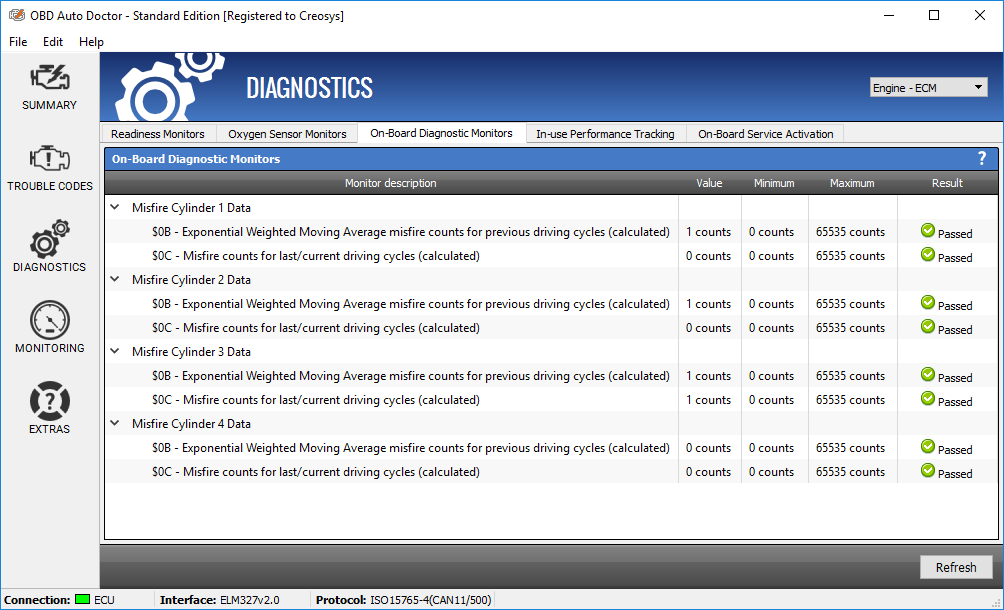What is Mode $06?
Mode $06 is an advanced diagnostic functionality mode included as part of the On-Board Diagnostic standard (OBD2). It keeps track on how emission control components and other systems and sensors are functioning.
Mode $06 allows access to the results for on-board diagnostic monitoring tests of these systems. These systems or components can be either continuously monitored (e.g. misfire monitoring) or non-continuously monitored (e.g. catalyst system). Continuous monitors run all the time while the non-continuous monitors run only after certain conditions are met.
OBD2 Mode $06 is sometimes referred just as Mode 6. The Mode 6 reveals the actual self-test data that is used by the OBDII system to detect faults and readiness monitor results. It enables more complete analysis of the DTCs and readiness monitor test results.
Mode $06 monitors
Here’s a list of the On-Board Diagnostic Monitors defined by the OBD2 standard at the moment. OBD Auto Doctor supports them all.
- Exhaust Gas Sensor Monitor
- Catalyst Monitor
- EGR Monitor
- VVT Monitor
- EVAP Monitor
- Exhaust Gas Sensor Heater Monitor
- Heated Catalyst Monitor
- Secondary Air Monitor
- Fuel System Monitor
- Boost Pressure Control Monitor
- NOx Adsorber Monitor
- NOx/SCR Catalyst Monitor
- Misfire Cylinder Data
- PM Filter Monitor
In addition to these standard defined monitors, manufacturers can have proprietary monitors. Our software can access the manufacturer specific Mode $06 data but it won’t be able to give the monitors or tests a name. It will give you the Monitor ID (OBDMID) and the Test ID (TID) and the data values. You will have to look up the meaning of those from the service manuals, or you can search the Internet for more help.
How can Mode 6 help?
The Mode 6 data can help you in many ways depending on your level of expertise and experience with cars. OBD Auto Doctor will give you the result and limit numbers plus the test result (pass/fail). The numbers can reveal a lot of the inner workings of the car if you are able to give the them a more detailed meaning in the correct context. The data can help you for example in the following ways:
- You can detect emerging problems before they set an active error code.
- You can find issues that are causing runnability problems, but that have not developed into active errors yet.
- You can use the data to identify whether a Diagnostic Trouble Code was set by a major failure or if the test just barely failed.
- You can verify that the repairs made have actually fixed the correct problem. You don’t need to wait for days for certain OBDII self-tests to run and possibly turn the Check Engine Light on.
Mode 6 data can reduce a lot of guesswork by eliminating components and systems out of the problem. But to get the most out of the data, you need to have a bit of knowledge of how the engine works.
Example: Engine Misfires
Many technicians find the misfire checking the most useful part of the Mode $06. Every time a cylinder misfires, the system increases the misfire counter for that cylinder. Only if the misfire count exceeds a certain threshold, it will result in a misfire trouble code. If the misfire count stays below the limit, no trouble code is set and no notice is provided for you. But you might be still able to feel the misfire when the engine is under heavy load or acceleration.

Example of OBD Auto Doctor reading OBD2 Mode $06 misfire data.
With the help of the OBD Auto Doctor, you can read the actual misfire counts recorded for each cylinder. The purpose of the misfire data is to help you identify which cylinders are currently misfiring and identify which cylinders have been consistently misfiring in previous driving cycles. Typically the misfire count should be equal or close to zero. In this case, there’s no problem. If a single cylinder misfire count is relatively higher compared to the other cylinder misfire counts, it indicates a possible issue. It tells that the cylinder is experiencing an abnormal behavior, and that there’s a problem with the ignition, fuel or compression in that cylinder. Remember that misfire counts for cylinder should only be compared relative to each other.
Final words
In this article, I explained the basics of the OBD2 Mode $06 also known as the On-Board Diagnostic Monitors. I hope the text gave you clear introduction to these monitors and how then can be used for car diagnostics. To get started analyzing your car, download our car diagnostic software for a PC or Mac now!
Please note that not all On-Board Diagnostic Monitor IDs or Test IDs are supported by all systems. The software is able to show only the monitors and tests that the car provides. Moreover, some older cars might not even support the Mode $06 at all. Use the free version of the software to see what data your car provides. Even the free version will list the available monitors and tests.
Get started
Get started with OBD Auto Doctor for free. Download the software and start diagnosing your car!